Workplace Diversity: Policy Awareness and Promotion Report
VerifiedAdded on 2020/01/28
|6
|1183
|57
Report
AI Summary
This report delves into the crucial aspects of workplace diversity, focusing on when and how to make staff aware of diversity policies. It emphasizes the importance of introducing these policies during the recruitment process to foster mutual respect and understanding among employees. The report highlights the benefits of a diverse workforce, including the synergy created by varied perspectives and the ability to navigate global markets. Furthermore, it outlines two key methods for promoting diversity policies: displaying them prominently in public areas and providing information during staff meetings. These strategies aim to create an inclusive environment where all employees feel valued and respected, contributing to a positive organizational culture and reputation. The report references several academic sources to support its claims.
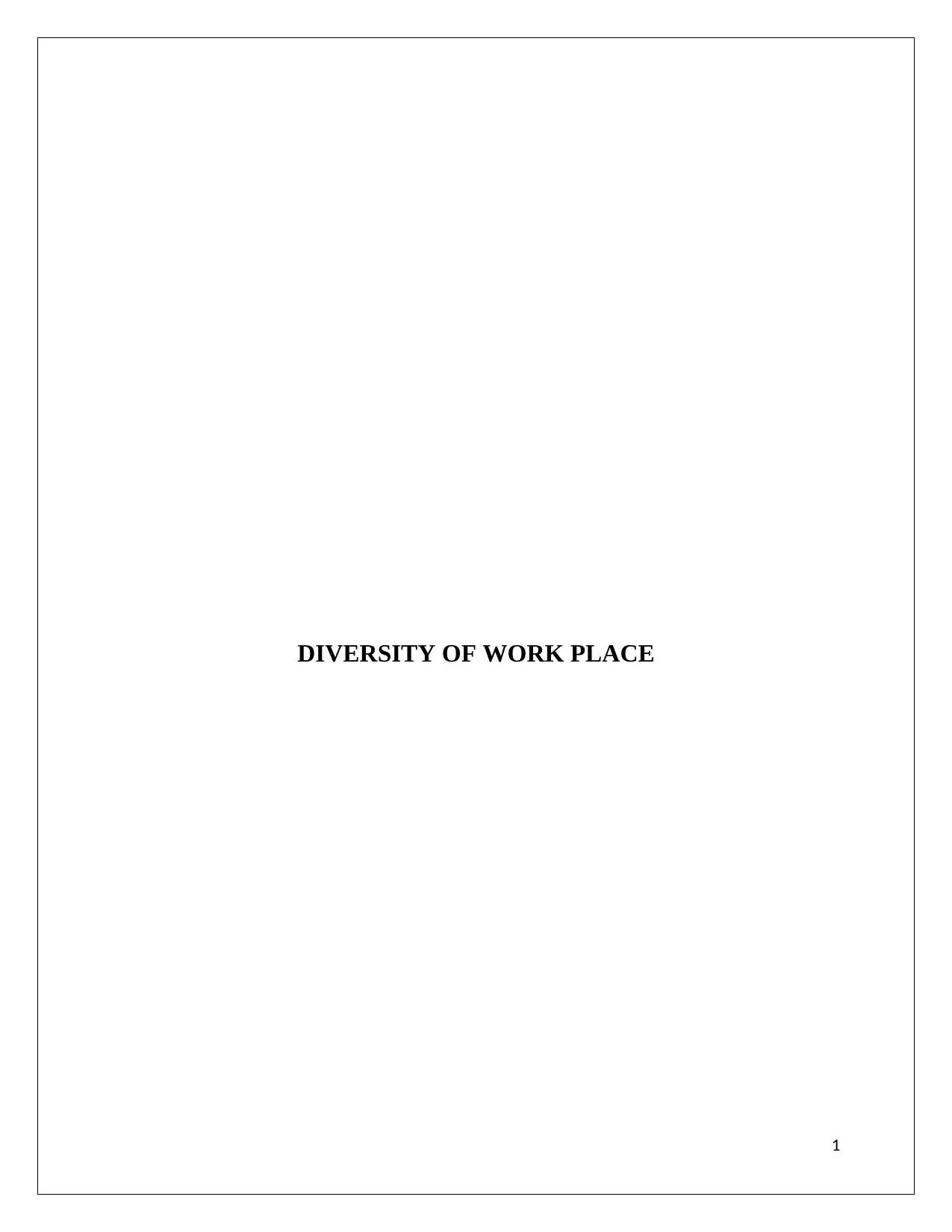
DIVERSITY OF WORK PLACE
1
1
Paraphrase This Document
Need a fresh take? Get an instant paraphrase of this document with our AI Paraphraser
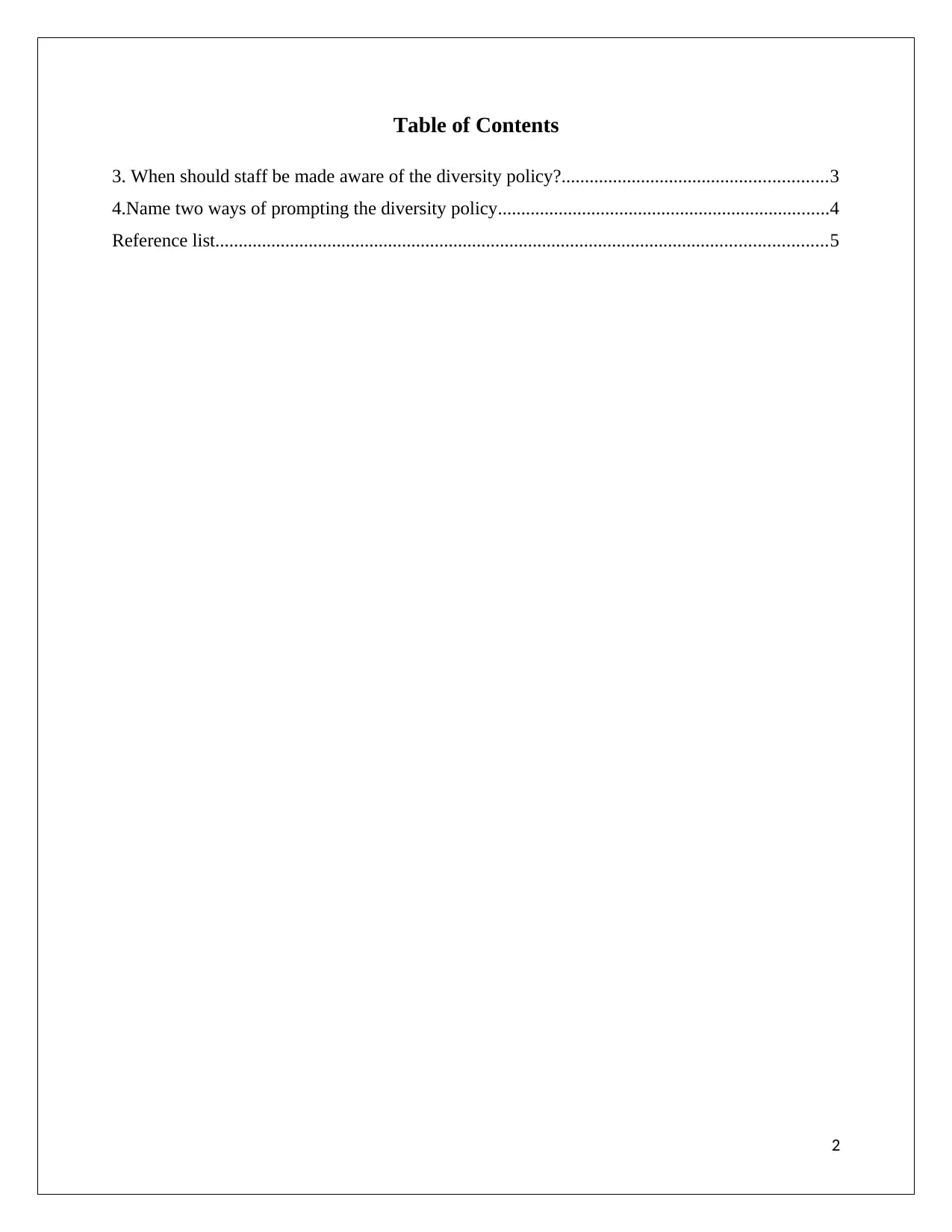
Table of Contents
3. When should staff be made aware of the diversity policy?.........................................................3
4.Name two ways of prompting the diversity policy.......................................................................4
Reference list...................................................................................................................................5
2
3. When should staff be made aware of the diversity policy?.........................................................3
4.Name two ways of prompting the diversity policy.......................................................................4
Reference list...................................................................................................................................5
2
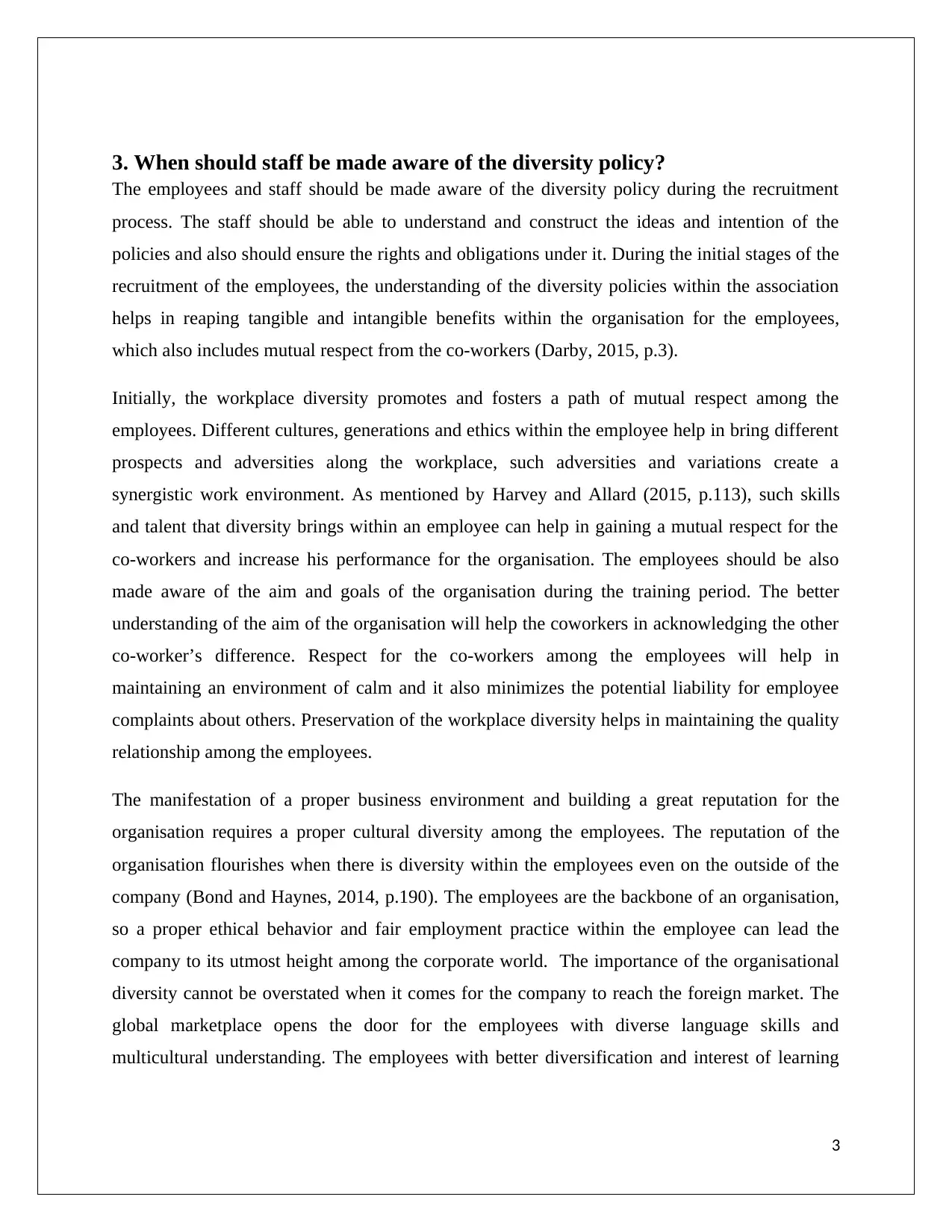
3. When should staff be made aware of the diversity policy?
The employees and staff should be made aware of the diversity policy during the recruitment
process. The staff should be able to understand and construct the ideas and intention of the
policies and also should ensure the rights and obligations under it. During the initial stages of the
recruitment of the employees, the understanding of the diversity policies within the association
helps in reaping tangible and intangible benefits within the organisation for the employees,
which also includes mutual respect from the co-workers (Darby, 2015, p.3).
Initially, the workplace diversity promotes and fosters a path of mutual respect among the
employees. Different cultures, generations and ethics within the employee help in bring different
prospects and adversities along the workplace, such adversities and variations create a
synergistic work environment. As mentioned by Harvey and Allard (2015, p.113), such skills
and talent that diversity brings within an employee can help in gaining a mutual respect for the
co-workers and increase his performance for the organisation. The employees should be also
made aware of the aim and goals of the organisation during the training period. The better
understanding of the aim of the organisation will help the coworkers in acknowledging the other
co-worker’s difference. Respect for the co-workers among the employees will help in
maintaining an environment of calm and it also minimizes the potential liability for employee
complaints about others. Preservation of the workplace diversity helps in maintaining the quality
relationship among the employees.
The manifestation of a proper business environment and building a great reputation for the
organisation requires a proper cultural diversity among the employees. The reputation of the
organisation flourishes when there is diversity within the employees even on the outside of the
company (Bond and Haynes, 2014, p.190). The employees are the backbone of an organisation,
so a proper ethical behavior and fair employment practice within the employee can lead the
company to its utmost height among the corporate world. The importance of the organisational
diversity cannot be overstated when it comes for the company to reach the foreign market. The
global marketplace opens the door for the employees with diverse language skills and
multicultural understanding. The employees with better diversification and interest of learning
3
The employees and staff should be made aware of the diversity policy during the recruitment
process. The staff should be able to understand and construct the ideas and intention of the
policies and also should ensure the rights and obligations under it. During the initial stages of the
recruitment of the employees, the understanding of the diversity policies within the association
helps in reaping tangible and intangible benefits within the organisation for the employees,
which also includes mutual respect from the co-workers (Darby, 2015, p.3).
Initially, the workplace diversity promotes and fosters a path of mutual respect among the
employees. Different cultures, generations and ethics within the employee help in bring different
prospects and adversities along the workplace, such adversities and variations create a
synergistic work environment. As mentioned by Harvey and Allard (2015, p.113), such skills
and talent that diversity brings within an employee can help in gaining a mutual respect for the
co-workers and increase his performance for the organisation. The employees should be also
made aware of the aim and goals of the organisation during the training period. The better
understanding of the aim of the organisation will help the coworkers in acknowledging the other
co-worker’s difference. Respect for the co-workers among the employees will help in
maintaining an environment of calm and it also minimizes the potential liability for employee
complaints about others. Preservation of the workplace diversity helps in maintaining the quality
relationship among the employees.
The manifestation of a proper business environment and building a great reputation for the
organisation requires a proper cultural diversity among the employees. The reputation of the
organisation flourishes when there is diversity within the employees even on the outside of the
company (Bond and Haynes, 2014, p.190). The employees are the backbone of an organisation,
so a proper ethical behavior and fair employment practice within the employee can lead the
company to its utmost height among the corporate world. The importance of the organisational
diversity cannot be overstated when it comes for the company to reach the foreign market. The
global marketplace opens the door for the employees with diverse language skills and
multicultural understanding. The employees with better diversification and interest of learning
3
⊘ This is a preview!⊘
Do you want full access?
Subscribe today to unlock all pages.

Trusted by 1+ million students worldwide
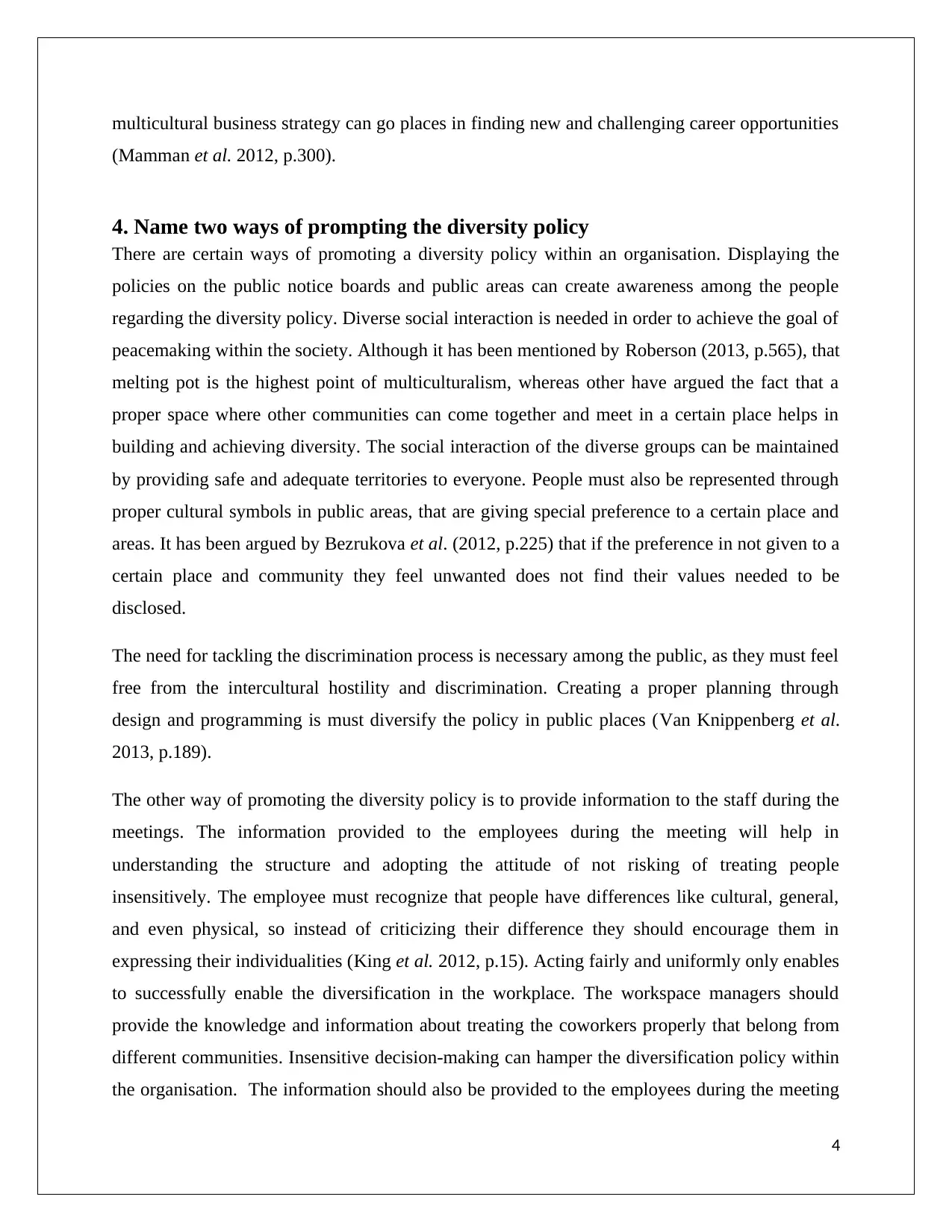
multicultural business strategy can go places in finding new and challenging career opportunities
(Mamman et al. 2012, p.300).
4. Name two ways of prompting the diversity policy
There are certain ways of promoting a diversity policy within an organisation. Displaying the
policies on the public notice boards and public areas can create awareness among the people
regarding the diversity policy. Diverse social interaction is needed in order to achieve the goal of
peacemaking within the society. Although it has been mentioned by Roberson (2013, p.565), that
melting pot is the highest point of multiculturalism, whereas other have argued the fact that a
proper space where other communities can come together and meet in a certain place helps in
building and achieving diversity. The social interaction of the diverse groups can be maintained
by providing safe and adequate territories to everyone. People must also be represented through
proper cultural symbols in public areas, that are giving special preference to a certain place and
areas. It has been argued by Bezrukova et al. (2012, p.225) that if the preference in not given to a
certain place and community they feel unwanted does not find their values needed to be
disclosed.
The need for tackling the discrimination process is necessary among the public, as they must feel
free from the intercultural hostility and discrimination. Creating a proper planning through
design and programming is must diversify the policy in public places (Van Knippenberg et al.
2013, p.189).
The other way of promoting the diversity policy is to provide information to the staff during the
meetings. The information provided to the employees during the meeting will help in
understanding the structure and adopting the attitude of not risking of treating people
insensitively. The employee must recognize that people have differences like cultural, general,
and even physical, so instead of criticizing their difference they should encourage them in
expressing their individualities (King et al. 2012, p.15). Acting fairly and uniformly only enables
to successfully enable the diversification in the workplace. The workspace managers should
provide the knowledge and information about treating the coworkers properly that belong from
different communities. Insensitive decision-making can hamper the diversification policy within
the organisation. The information should also be provided to the employees during the meeting
4
(Mamman et al. 2012, p.300).
4. Name two ways of prompting the diversity policy
There are certain ways of promoting a diversity policy within an organisation. Displaying the
policies on the public notice boards and public areas can create awareness among the people
regarding the diversity policy. Diverse social interaction is needed in order to achieve the goal of
peacemaking within the society. Although it has been mentioned by Roberson (2013, p.565), that
melting pot is the highest point of multiculturalism, whereas other have argued the fact that a
proper space where other communities can come together and meet in a certain place helps in
building and achieving diversity. The social interaction of the diverse groups can be maintained
by providing safe and adequate territories to everyone. People must also be represented through
proper cultural symbols in public areas, that are giving special preference to a certain place and
areas. It has been argued by Bezrukova et al. (2012, p.225) that if the preference in not given to a
certain place and community they feel unwanted does not find their values needed to be
disclosed.
The need for tackling the discrimination process is necessary among the public, as they must feel
free from the intercultural hostility and discrimination. Creating a proper planning through
design and programming is must diversify the policy in public places (Van Knippenberg et al.
2013, p.189).
The other way of promoting the diversity policy is to provide information to the staff during the
meetings. The information provided to the employees during the meeting will help in
understanding the structure and adopting the attitude of not risking of treating people
insensitively. The employee must recognize that people have differences like cultural, general,
and even physical, so instead of criticizing their difference they should encourage them in
expressing their individualities (King et al. 2012, p.15). Acting fairly and uniformly only enables
to successfully enable the diversification in the workplace. The workspace managers should
provide the knowledge and information about treating the coworkers properly that belong from
different communities. Insensitive decision-making can hamper the diversification policy within
the organisation. The information should also be provided to the employees during the meeting
4
Paraphrase This Document
Need a fresh take? Get an instant paraphrase of this document with our AI Paraphraser
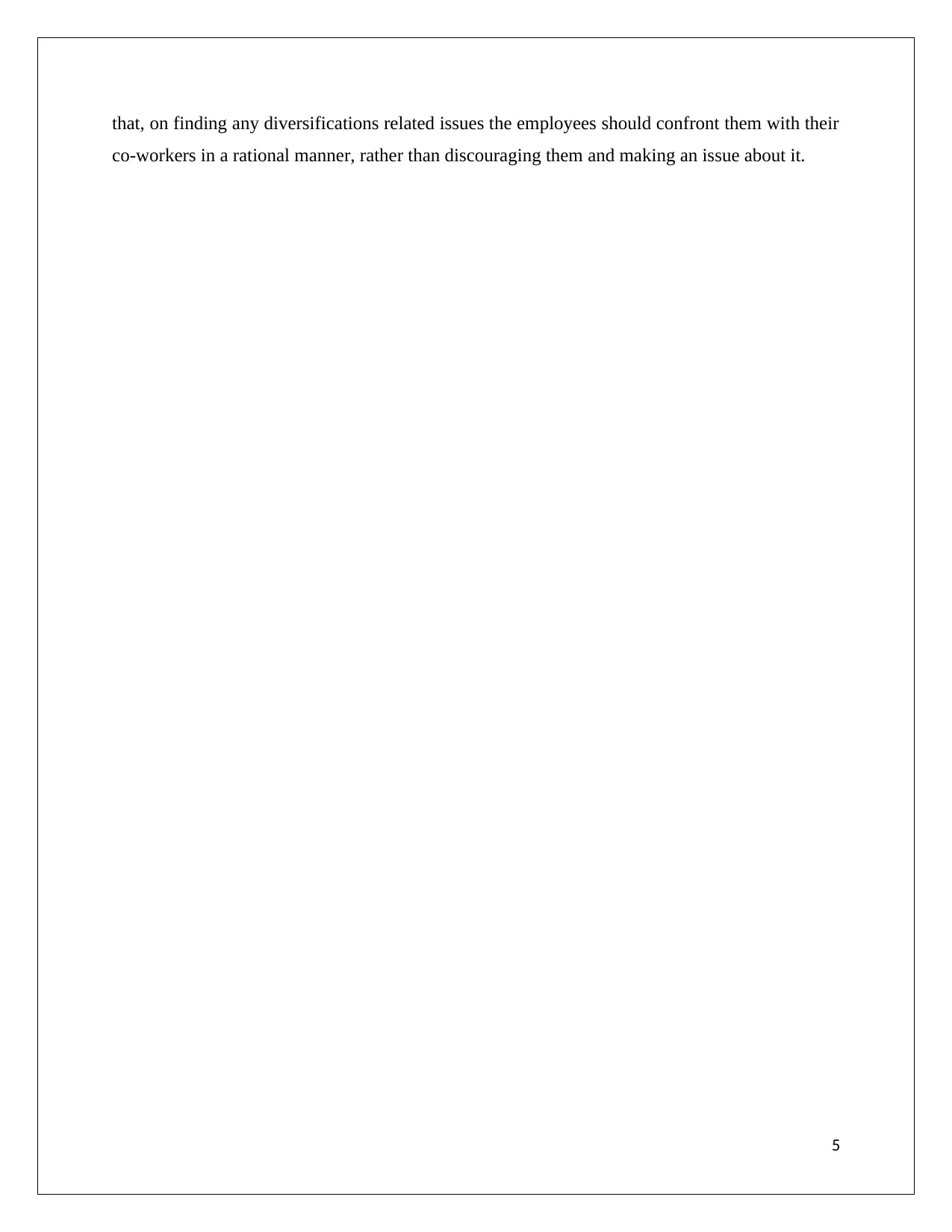
that, on finding any diversifications related issues the employees should confront them with their
co-workers in a rational manner, rather than discouraging them and making an issue about it.
5
co-workers in a rational manner, rather than discouraging them and making an issue about it.
5
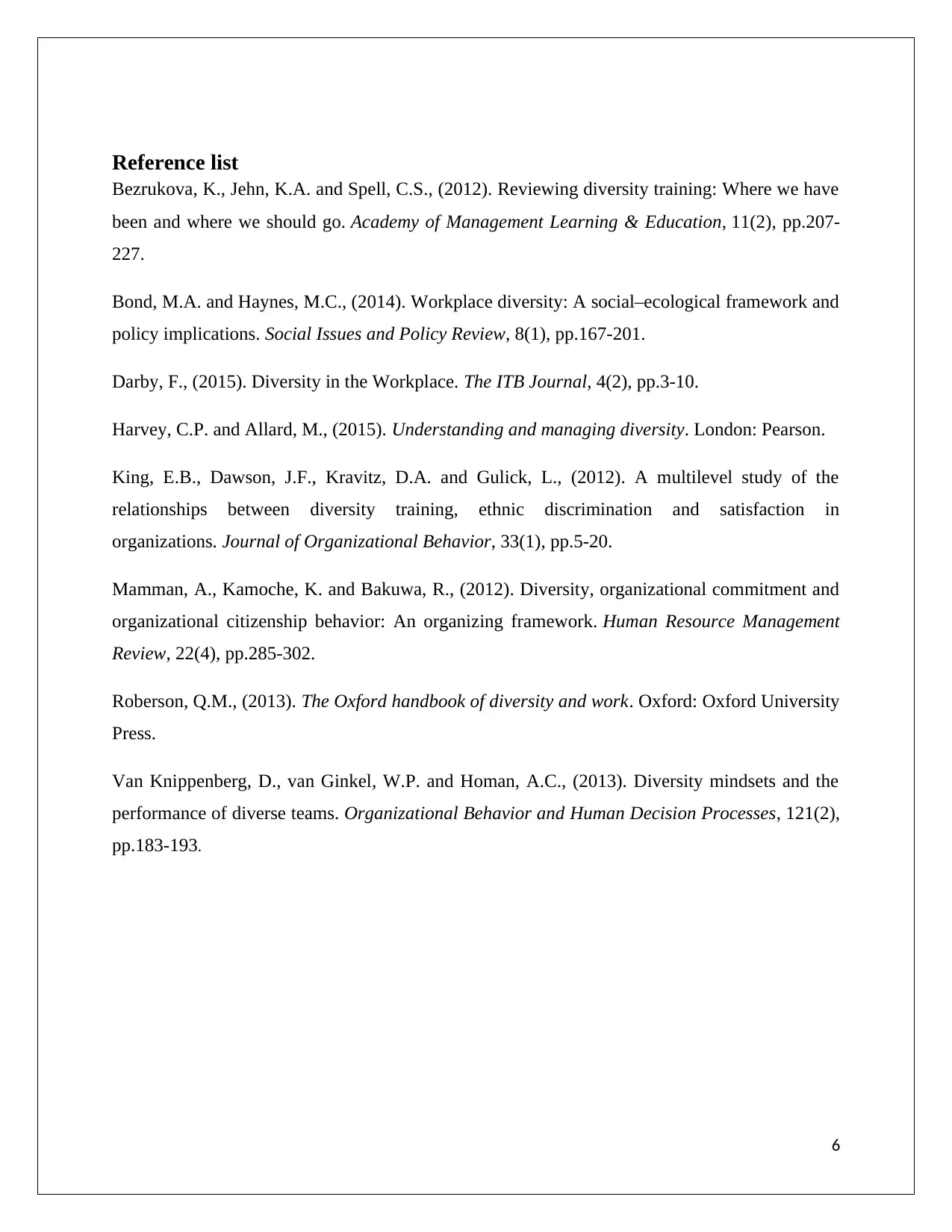
Reference list
Bezrukova, K., Jehn, K.A. and Spell, C.S., (2012). Reviewing diversity training: Where we have
been and where we should go. Academy of Management Learning & Education, 11(2), pp.207-
227.
Bond, M.A. and Haynes, M.C., (2014). Workplace diversity: A social–ecological framework and
policy implications. Social Issues and Policy Review, 8(1), pp.167-201.
Darby, F., (2015). Diversity in the Workplace. The ITB Journal, 4(2), pp.3-10.
Harvey, C.P. and Allard, M., (2015). Understanding and managing diversity. London: Pearson.
King, E.B., Dawson, J.F., Kravitz, D.A. and Gulick, L., (2012). A multilevel study of the
relationships between diversity training, ethnic discrimination and satisfaction in
organizations. Journal of Organizational Behavior, 33(1), pp.5-20.
Mamman, A., Kamoche, K. and Bakuwa, R., (2012). Diversity, organizational commitment and
organizational citizenship behavior: An organizing framework. Human Resource Management
Review, 22(4), pp.285-302.
Roberson, Q.M., (2013). The Oxford handbook of diversity and work. Oxford: Oxford University
Press.
Van Knippenberg, D., van Ginkel, W.P. and Homan, A.C., (2013). Diversity mindsets and the
performance of diverse teams. Organizational Behavior and Human Decision Processes, 121(2),
pp.183-193.
6
Bezrukova, K., Jehn, K.A. and Spell, C.S., (2012). Reviewing diversity training: Where we have
been and where we should go. Academy of Management Learning & Education, 11(2), pp.207-
227.
Bond, M.A. and Haynes, M.C., (2014). Workplace diversity: A social–ecological framework and
policy implications. Social Issues and Policy Review, 8(1), pp.167-201.
Darby, F., (2015). Diversity in the Workplace. The ITB Journal, 4(2), pp.3-10.
Harvey, C.P. and Allard, M., (2015). Understanding and managing diversity. London: Pearson.
King, E.B., Dawson, J.F., Kravitz, D.A. and Gulick, L., (2012). A multilevel study of the
relationships between diversity training, ethnic discrimination and satisfaction in
organizations. Journal of Organizational Behavior, 33(1), pp.5-20.
Mamman, A., Kamoche, K. and Bakuwa, R., (2012). Diversity, organizational commitment and
organizational citizenship behavior: An organizing framework. Human Resource Management
Review, 22(4), pp.285-302.
Roberson, Q.M., (2013). The Oxford handbook of diversity and work. Oxford: Oxford University
Press.
Van Knippenberg, D., van Ginkel, W.P. and Homan, A.C., (2013). Diversity mindsets and the
performance of diverse teams. Organizational Behavior and Human Decision Processes, 121(2),
pp.183-193.
6
⊘ This is a preview!⊘
Do you want full access?
Subscribe today to unlock all pages.

Trusted by 1+ million students worldwide
1 out of 6
Related Documents
Your All-in-One AI-Powered Toolkit for Academic Success.
+13062052269
info@desklib.com
Available 24*7 on WhatsApp / Email
![[object Object]](/_next/static/media/star-bottom.7253800d.svg)
Unlock your academic potential
Copyright © 2020–2025 A2Z Services. All Rights Reserved. Developed and managed by ZUCOL.





